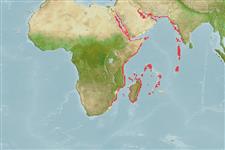Common names from other countries
>
Blenniiformes (Blennies) >
Tripterygiidae (Triplefin blennies) > Tripterygiinae
Etymology: Enneapterygius: Greek, ennea = nine times + Greek, pterygion = little fin (Ref. 45335).
Environment: milieu / climate zone / depth range / distribution range
экология
морской ассоциированный с рифами; пределы глубины 1 - 14 m (Ref. 88983), usually 1 - ? m (Ref. 88983). Tropical
Western Indian Ocean: Red Sea, along East African coast to southern Kwazulu-Natal, Mauritius, Seychelles, Comoros and St. Brandon Shoals; not recorded in Gulf of Oman.
Size / Вес / Возраст
Maturity: Lm ? range ? - ? cm
Max length : 2.5 cm SL самец/пол неопределен; (Ref. 88983)
колючие лучи спинного плавника (общее число): 14 - 16; членистые (мягкие) лучи спинного плавника (общее число): 9-10; колючие лучи анального плавника 1; членистые (мягкие) лучи анального плавника: 17 - 18; позвонки: 34 - 36. This species is distinguished by the following characters: low first dorsal fin, brown and green radii around the eye, males with yellow body and melanophores on head to base of pectoral fins, females with yellow-green body, brown stripe on nose and orange bar below eye; further, D III + XI-XIII + 9-10 (usually III + XII + 10); A I, 17-18 (usually 18 rays); pectoral fin 15: usually 3, 5, 7; lateral line with pored scales12-14, notched scales 20-23 (usually 22); longitudinal scale series 31; dentary pores 3 + 1 + 3 ; head 3.2-3.8 in SL; eye 2.9-3.7 in HL; nape partially scaled, abdomen no scales, single row of scales at base of caudal fin; supratemporal sensory canal crescent-shaped; supraorbital cirrus small and pointed; first dorsal fin about equal in height to second in males, lower in females (Ref. 57774, 88983).
Adults occur in shallow, sheltered waters, on hard corals; found on the upper part of coral reefs, usually along the reef margin in depths of about 1 m, often on corals covered by low algae. Also found in bays or sheltered lagoons (Ref. 88983). Eggs are hemispherical and covered with numerous sticky threads that anchor them in the algae on the nesting sites (Ref. 240). Larvae are planktonic which occur primarily in shallow, nearshore waters (Ref. 94114).
Life cycle and mating behavior
половая зрелость | размножение | нерест | икра | Fecundity | личинки
Holleman, W. and S.V. Bogorodsky, 2012. A review of the blennioid fish family Tripterygiidae (Perciformes) in the Red Sea, with description of Enneapterygius qirmiz, and reinstatement of Enneapterygius altipinnis Clark, 1980. Zootaxa 3152:36-60. (Ref. 88983)
Статус Красного Списка МСОП (Ref. 130435)
CITES (Ref. 128078)
Not Evaluated
Угроза для людей
Harmless
Использование человеком
дополнительная информация
ссылкиаквакультура (рыбоводство)особенности рыбоводствастепень растяжениягенетикаElectrophoresesнаследуемостьболезниобработкаMass conversion
соавторыизображенияStamps, Coins Misc.звукиCiguateraскоростьтип плаванияжаберная областьOtolithsмозгзрение
инструменты
Специальные отчеты
Скачать в формате XML
ресурсы в Интернет
Estimates based on models
Preferred temperature (Ref.
115969): 24.8 - 29.1, mean 27.5 (based on 669 cells).
Phylogenetic diversity index (Ref.
82804): PD
50 = 0.5000 [Uniqueness, from 0.5 = low to 2.0 = high].
Bayesian length-weight: a=0.00794 (0.00346 - 0.01822), b=3.08 (2.88 - 3.28), in cm Total Length, based on LWR estimates for this (Sub)family-body shape (Ref.
93245).
Trophic level (Ref.
69278): 3.1 ±0.3 se; based on size and trophs of closest relatives
устойчивость к внешним воздействиям (Ref.
120179): высокий, минимальное время удвоения популяции до 15 месяцев (Preliminary K or Fecundity.).
Fishing Vulnerability (Ref.
59153): Low vulnerability (10 of 100).
